Geof Huth's Blog, page 16
February 11, 2012
A Poetics (# 94)
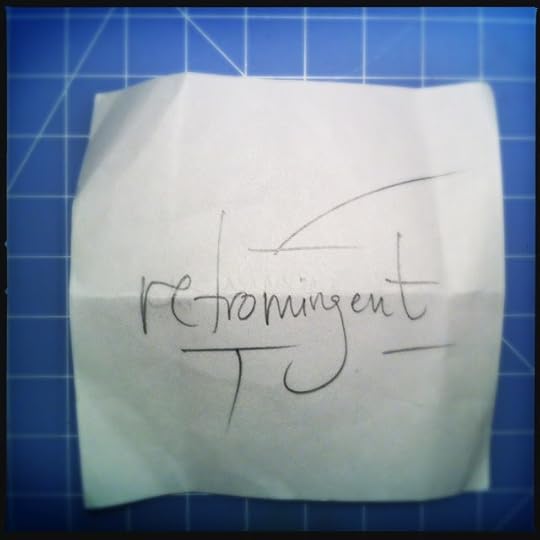
94. erupt
The poem is the eruption, the movement outward from us, the manifestation of the inclination, the captured fact of the poet's interaction with and reaction to the world. Sometimes, the poem goes backwards, and that is the surprise that wakes us. Yet there are no dreams, just different states of reality.
ecr. l'inf.
Published on February 11, 2012 07:35
February 10, 2012
Tony Tony Dohr's Door
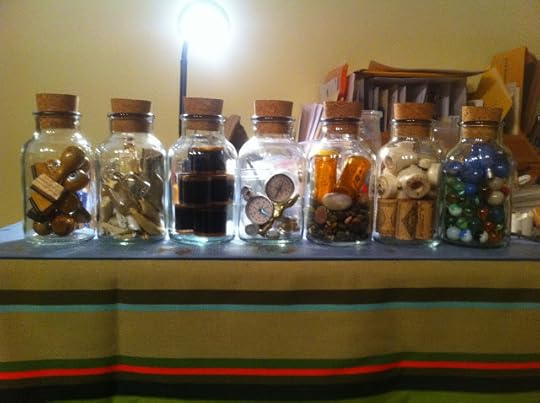 Geof Huth, "Every Poem Ever Written: Numbers 4 through 10 in Progress" (10 February 2012)
Geof Huth, "Every Poem Ever Written: Numbers 4 through 10 in Progress" (10 February 2012)Everything is structure or disorder, order or chaos, and the poet learns to work in both realms at once. The poet must learn to create order but allow disorder to roam within it. Because poets understand that, their verbo-visual works interest me more than those of artists. An artist will write something obvious and expect us to appreciate the irony of the wording. A poet will write something ambiguous and expect us to appreciate the inability to understand if the poet is ironic or not.
So it is that I began work on a massive expansion of my poem in progress, "Every Poem Ever Written."
I love that title, for reasons that I had explained to Anne Gorrick a few days ago:
She had no comment on these words. But Douglas Rothschild (AKA Tony Dohr on Facebook) did.
I was thinking of a future publication as a book of photos of my jar poems, which I conceived, long ago, as a long poem. I've already given away the title: Every Poem Ever Written, which has a bit of pomposity to it, but which is supposed to refer to how objects have poetic power when we are focused on the right collections or presentation [of] them.
While sitting in McGeary's Irish Pub tonight, and even earlier now that I think of it, Douglas told me that my chosen title was a bad one, that I would turn off half my readership ("Two people!" I thought) by using that title, and he urged me to use "The Romantic Canon" as a title. And by "urged," I mean "demanded," because Douglas is nothing if not opinionated.
Strangely, I don't care if people have opinions different from mine, especially whenever I can do whatever I want anyhow. He said that the title showed I was full of myself and that he didn't want me to be full of myself as another poet he knew was. (Okay, I'll keep that person's name secret, though he may be somehow associated with the Language poets.) I told him that two things were at play: 1. I am not full of myself. I understand my limitations are many and my effects on others are few, so I am not conceited enough to think I could write every poem ever written, but that is the reason I can write "Every Poem Ever Written." And I told him that the objects in the poems extended the poems into a representation of the world as a whole, that as part of the world they represented the entirety of it. Synechdoche we call it. I lived there once.
All of this drove Douglas (who forgot, as I did, to get me that mummified bat he'd promised me) batty. He argued that these objects didn't include samples of everything in the world, which demonstrated that he didn't understand the usefulness of synechdoche (wherein merely one object could represent the world). But I stood firm. I liked his title quite a bit, but I didn't want to take something he had designed (that title). I wanted my own title, and I wanted something that challenged the reader/viewer, something that would throw that person off kilter.
Douglas was also with me when I was filling seven jars with objects I had collected for many years. Think about this: I have been collecting many strange objects for decades, with no purpose to the collection except that, someday, I would use them in a "project." Now, the project, as if a complete surprise, is here, and I am working on it with deliberate speed, as if my life depended on it (as if any life depended on poetry, depended on art). While watching me fill these jars, deliberately but tentatively (because I was experimenting, I was checking), Douglas frequently had opinions and spouted them, and I agreed with him often, though usually only because I had already noted what he had. It's just that I had done so quietly.
I had, by mid-evening, assembled seven good starts to these object poems (most without words so far), and later tonight I assembled an eighth start, so I am eleven sections into this long poem as objects. And I realized something strange: I loved that these poems are more beautiful than the scattered pieces they only until recently were, and I loved that putting these pieces in this jars neatened the mess that preceded them. I loved that these poems were carefully structured, but also dependent on aleatoric modification, that they were not stable unitary constructions. I loved that they were alive.
After sitting in a bar for a few hours, Douglas and I walked past the state capitol (unlike most and maybe all other state capitols) and across the Empire State Plaza, which is one grand monument to mid-century boring architecture, but which is still impressively monumental, and which has become something I like, even something like home. The moon was a vague hazy disk behind the cover of clouds, and it was all beautiful.
So my thanks to Douglas for a night out, and remember what I told my friend Nico Vassilakis:
We don't have to be great poets. We have to be dedicated ones.
And so we are.
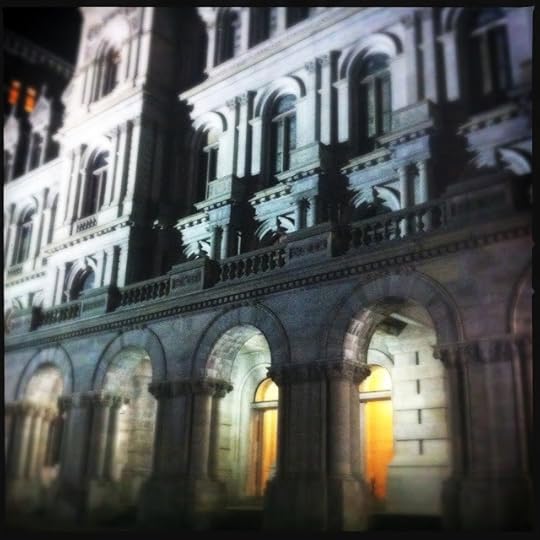 New York State Capitol (11 February 2012)
New York State Capitol (11 February 2012)ecr. l'inf.
Published on February 10, 2012 22:21
February 9, 2012
Why it Doesn't Matter
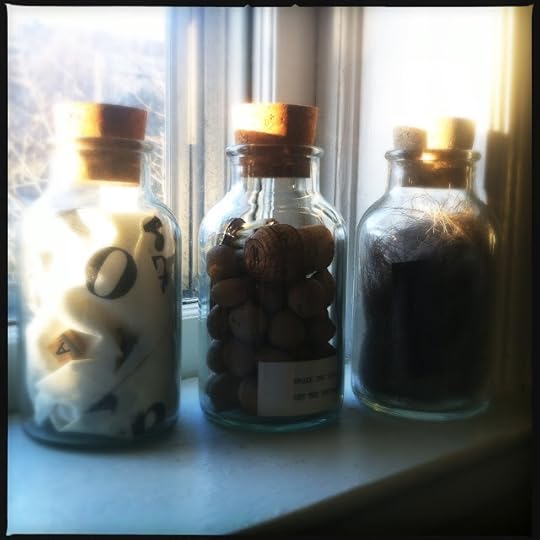
It never did.
There were too many of them.
The sunlight had a buttery feeling.
Words were not enough.
You had dropped the glass into pieces.
Blood came readily.
Those times when you lost everything.
Value before virtue.
The tenderness of terror.
A grave desire for sleep.
The way you imagined it would be.
Twice with the first error, thrice with the second.
A lack of balance.
Cautionary tails, and the deer disappeared, tail last.
Versions of virgins.
Piddling issues not relating to piddling.
Portion control instead of abstinence.
The scent you could not remember deeply enough to forget.
Simply the numbers.
Accumulations of sadness.
Eraser crumbs.
Desultory intentions.
Meaningful lack of direction.
A lungful cry.
Barriers and haywire.
Bread broken but set aside.
The empty plate.
The loneliness of the knife.
Butter turned putrid.
Pills on each of your sweaters, even the red one.
Syringes but not syrinxes.
Humble bravado.
All manner of misdirection.
The beating of.
Crying of the lambs.
Forty-nine other reasons.
Minced eyes.
Conduits without purpose.
It all ends anyway.
ecr. l'inf.
Published on February 09, 2012 20:21
February 8, 2012
Every Poem Ever Written
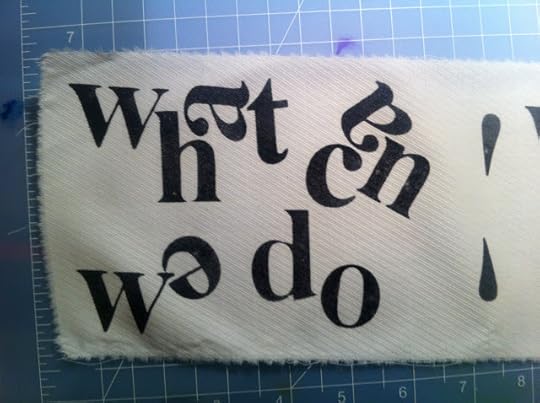 Geof Huth, Part of "Every Poem Ever Written: 1. varied in the face of words" (finished 8 February 2012)
Geof Huth, Part of "Every Poem Ever Written: 1. varied in the face of words" (finished 8 February 2012)I have finished two poems today because I have been attacked by small bouts of inspiration. The Martians are all around me now.
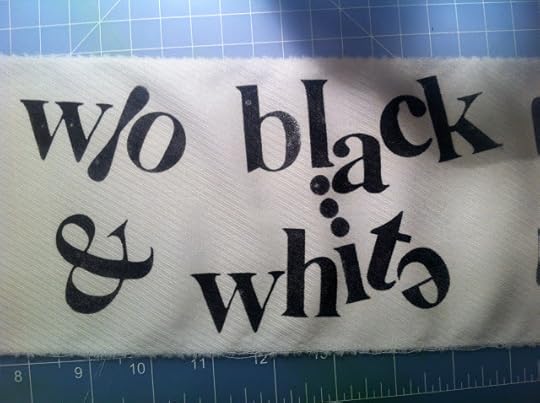
The first part of the inspiration came the other day. For years, I have saved the glass bottles, stoppered with fat corks, that my sea salt and peppercorns came in (for, you see, I am someone obsessed with food, so I need fresh-ground pepper and salt in my food). My plan has always been to create object poems by filling these containers with words and objects (as if these were two separate things). But I've been collecting the jars for years, and I've had a few objects tossed erratically in one of the jars for months.
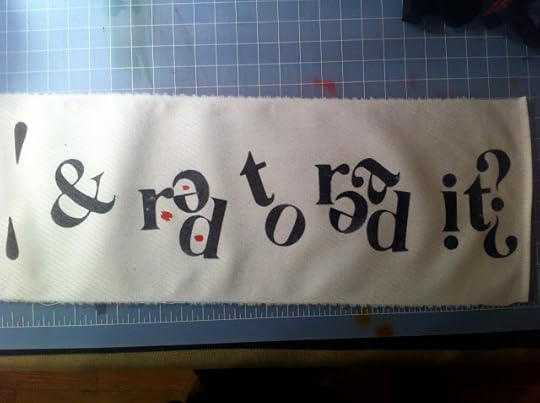
But this weekend I discovered my problem, a problem I hadn't even realized existed: I needed a way to hold the pieces within the bottles. And I figured this out when I collected a handful of loose deer fur at Anne Gorrick and Peter Genovese's house, and I discovered how that fur could hold objects and words in place.
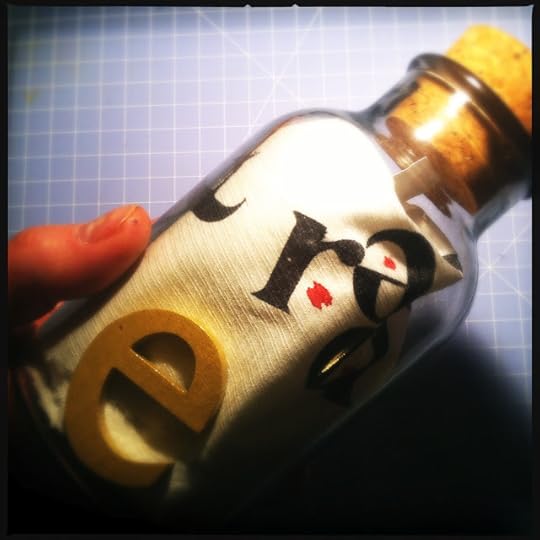
Because of this revelation, I realized this week that I could use an old shirt of mine that I had torn into shreds (for some undefined future project) to fill in the first bottle I had been working on, so I ironed two pieces of the cloth, and I stamped the text of a poem onto one of them. Then I folded these two pieces and slipped them into the bottle, so that the text cannot quite be read, just as the text I'd typed on a card on Sunday and slipped into the middle of this cloth also cannot quite be red. I am forcing myself into the uncomfortable position of hiding text from the reader to enhance the experience of the reader. The pleasure of the text arises from subtle and imperfect revelation. Along with the stamping, I've included something red (and "read"): red and human blood, my blood, marking this first section of the poem "Every Poem Ever Written" as irretrievably mine. It carries my DNA into the future.
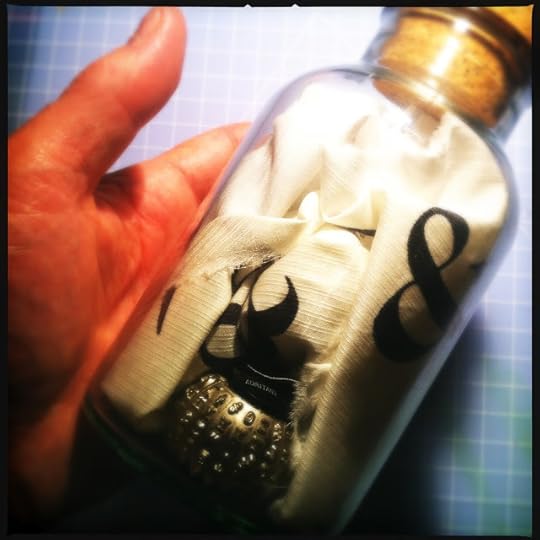
Along with this stamped and bloody cloth, this jar includes a metal "element" (type ball) from an IBM Selectric typewriter, letter A from a Scrabble set, a large metal e that I found in Albany, a metal shoe from a Monopoly game, and a small poem typed onto a piece of watercolor paper.
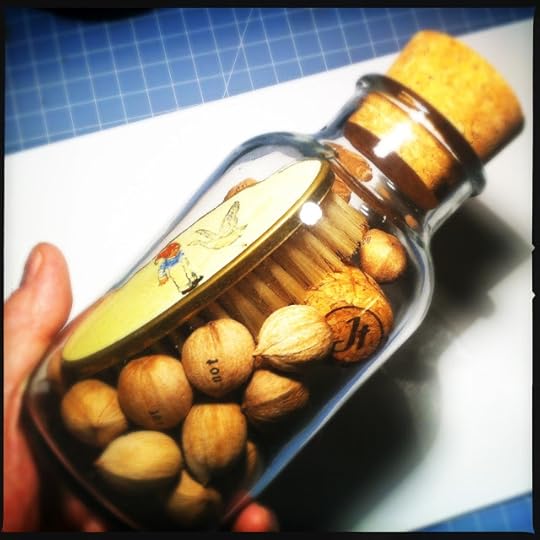 Geof Huth, "Every Poem Ever Written: 3. not It" (finished 8 February 2012)
Geof Huth, "Every Poem Ever Written: 3. not It" (finished 8 February 2012)With the inspiration of the cloth in hand, I suddenly had another idea. Years ago, sometime in the early 1990s, just before I abandoned poetry for eight years, I had stamped 35 hickory nuts with the word "not." Tonight, I realized a good purpose for them, and I poured them into a jar.
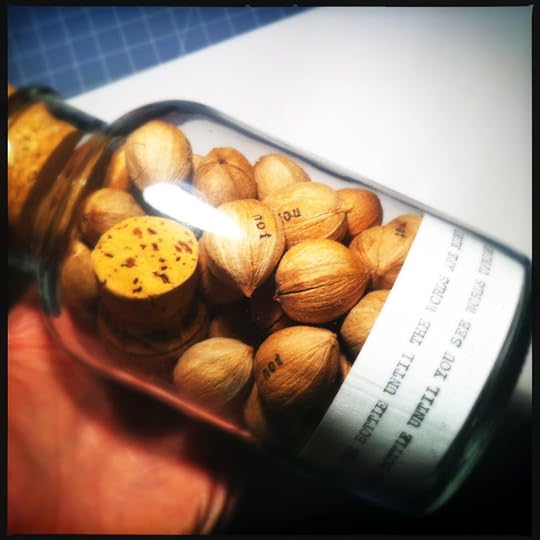
But I needed to make a poem out of them, so I decided to use a discarded typed-upon card in this jar (but to curl it around the inside of the jar's curvature), and I added a cork with the word "It" upon its top, and I added one special item, something that pained me to add: the hairbrush from my childhood. I have, thus, made these two poems quite personal. They are me. I inhabit them in a physical way (at least one of my hairs must still be sequestered in the bristles of that brush). And these poems inhabit me.
ecr. l'inf.
Published on February 08, 2012 20:57
February 7, 2012
Word & Wax & Wonder
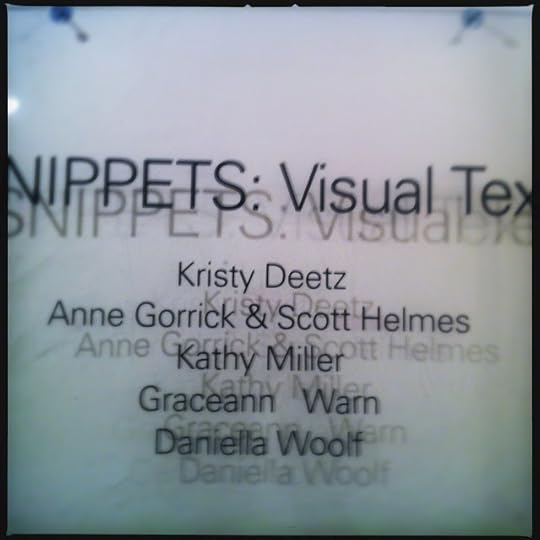 (Yes, I see the extra space between "Graceann" and "Warn," and it does drive me crazy)
(Yes, I see the extra space between "Graceann" and "Warn," and it does drive me crazy)Last Saturday, February 4th, I made my way to Kingston, New York, to the gallery at R&F Paints, a space I have visited often for performances of poetry, but one that I visited that day for "Snippets: Visual Text," an exhibition of verbo-visual encaustic artworks that included many collaborations between my two friends, Scott Helmes and Anne Gorrick, a pair of people who had collaborated through the mails so that that Saturday was the first time they had ever met, and I was the one who introduced them, in person, to each other.
But they were not the only ones in the exhibition. The only other artist I spoke to that night was Kathy Miller, who came up to me asking me if I were one of the artists, and noting that she was but she did not know the other artists. I assured Kathy I was not an artist, and I introduced her to Anne.
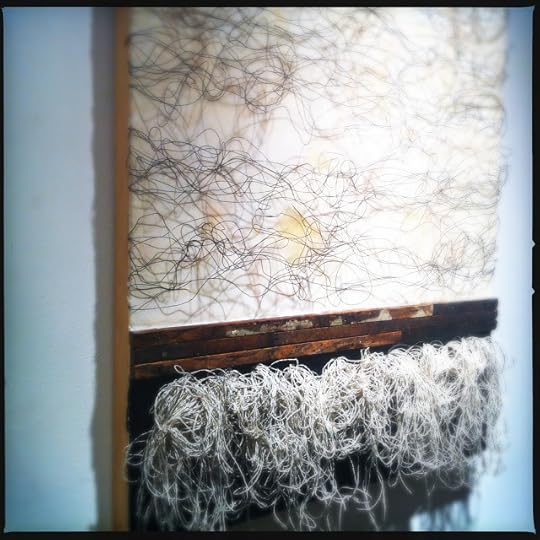
Kathy's pieces were large multimedia works that included squiggles of wire (metaphors for writing) over fields of white encaustic (metaphor for a sheet of paper), rows of worn wood, and profusions of string made by tearing sheets from books, cutting them into strips, and twisting them into string. These pieces were quite beautiful (though well outside my price range).
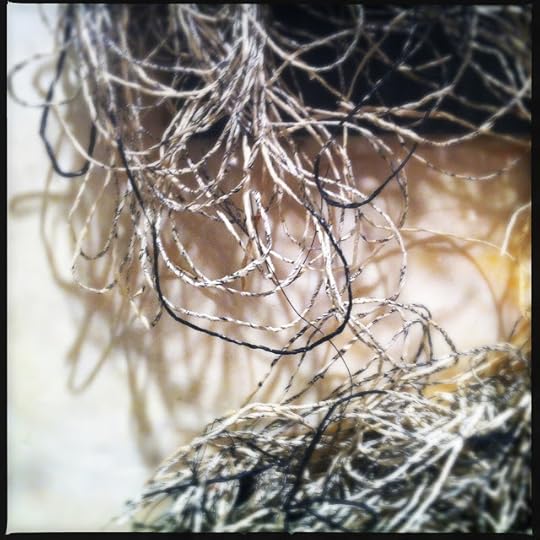
Looking closely at Kathy's pieces, I could see the specks of ink that were the text in these pieces. This is just one of the ways that text is represented in the artworks in this exhibitions, and the range of representation is, literally, as wide as possible.
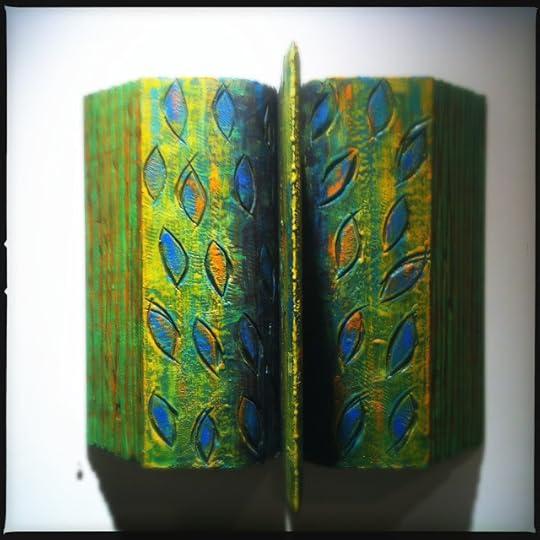
Kristy Deetz, for instance, was at the far textless end. In her pieces, text was represented primarily by association. All of her works were scultptures carved of wood and covered in encaustics. These pieces were booklike and bookshaped, but entirely textless. This one piece of hers has four pages covered with leaves (leaves of a book covered with leaves), making this the one example that almost represents text. I found these books the least successful of the show, though they had features I did enjoy: one book, for instance, had a hole hollowed out of the center of it, a nest sitting within it, and stones representing eggs.
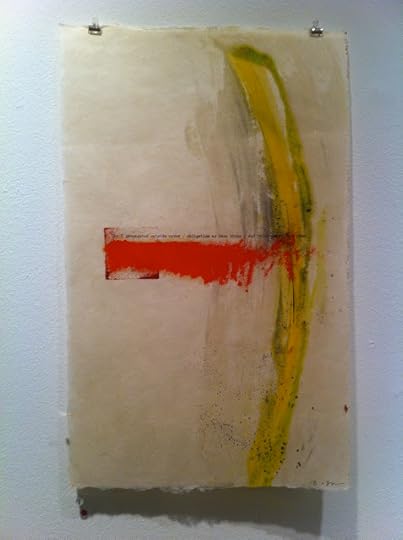
At the other extreme of textuality were Anne Gorrick and Scott Helmes' works, and, sure, they were my favorite, so much so that I had purchased five of them before I'd left the gallery. This one above belongs to me, and it is my favorite piece in the entire show. The colors, the perfected imperfect shapes, and that little grey string of Anne's words running through the storm of color make this a piece that makes me ache. The text is tiny on the page but beautiful and essential. This is real visual poetry, created by two people who had never met. This is something to spend a life with, so I made the decision to do it.
It is possible, if not likely, that I like Scott and Anne's pieces because they are the most visual poetic, but it is that synergy I look for so it is that synergy that I am drawn to. Some may believe I love their work because they are my friends and good people, but there are plenty of people in both those categories whose work I enjoy only marginally. Both these artists have worked with their hands enough to make beauty, and Anne, the maker of the readable words, is a poet given over to the word. She has already sacrificed herself on that altar. Ink flows through her veins, and wax through her fingers. Scott's control of brushstrokes is firm right now, after so many years, that his hand simply makes beauty naturally, because his eye has taught him how, and his eye never fails us. (I know. I've gone through piles of their collaborations, and he can see which are the best.)
One of the wonderful parts of this show was that Anne and Scott's pieces were run across two opposite sides of the same wall, in two lines opposing one another. They ran as lines of text in a single book.
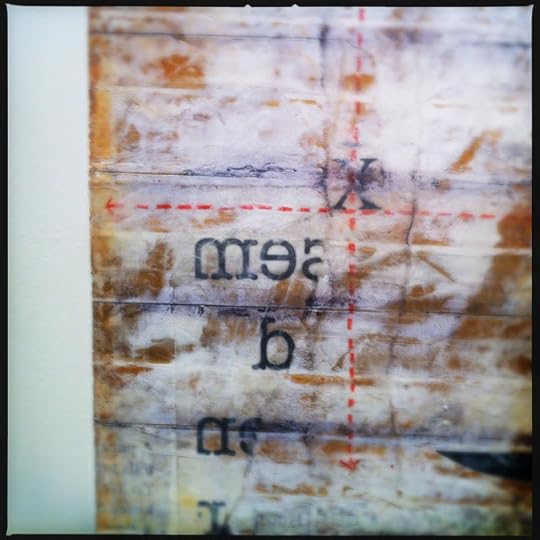
In the mid-range of textuality were the works of Graceann Warn, who produced large-scale works with scraps of text. These were fine vispoetic pieces in their own right, spooky through what was left out of their words, and made more palpable, if not sometimes menacing, by their size. Apparently, these were constructed with found texts, and the first piece of text (a tiny scrap) that I saw within one of her tall pieces included a long s, setting off reverberations of reference within my head, though maybe it was only me.
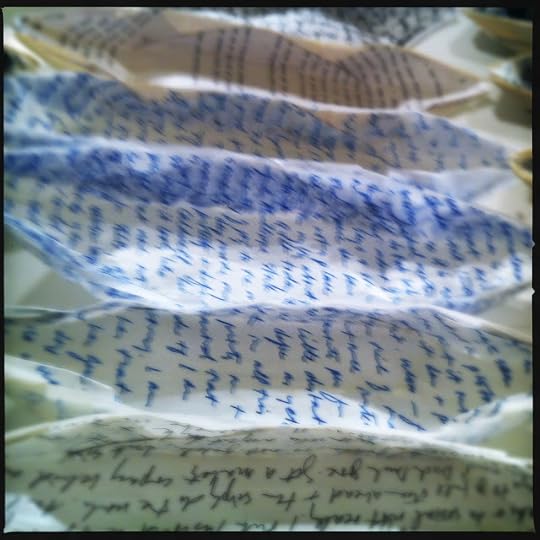
If I were fair, I would argue that Daniella Wolf's pieces were the most textual, because she has constructed it from hundreds of boatlike structures covered in waxy encaustics, sewn together, and hung on a wall in such a way that they replaced the wall in our perception of the space. But her text works differently from that in Scott and Anne's work. Each of these boats is created from some found text (sometimes from handwritten correspondence, sometimes from printed sources), and the text, though readable and accessible (at least in parts), is impossible to ingest in toto. It is there as the representation of text. It reminds us that text records and documents everything, so it means everything, so it can represent everything, and here that is exactly what it does represent.
Although this is a beautiful work, it was not one of my favorites in this very good show. But it caught or spurned the light quite beautifully, the stitches holding this delicate contraption together were a joy to behold, and when I leaned into the piece I could smell the beautiful sweet beeswax of the encaustic, and I realized I was trapped in a honeycomb of words.
ecr. l'inf.
Published on February 07, 2012 20:44
February 6, 2012
deerlaid plans
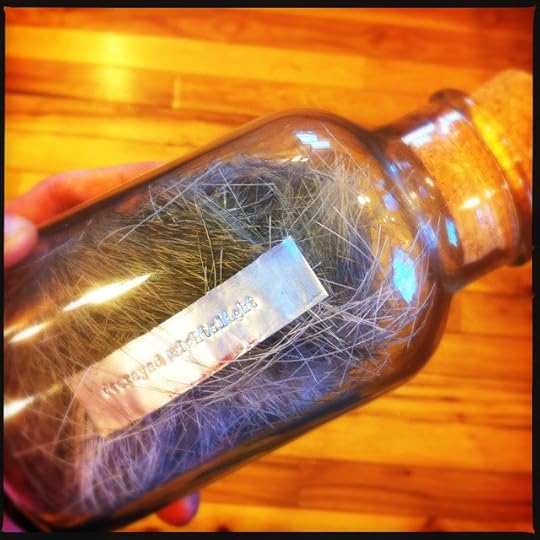 Geof Huth, "deereyed nightslight" (5 February 2012)
Geof Huth, "deereyed nightslight" (5 February 2012)A handful of deer fur sheered off the hide, and the body itself lying nearby, twisted unnaturally, but placid in death.
Handful of deer fur and a slight musk off it, something of the rotted earth.
Stuffed in a twist into the jar, in a swirling, as if movement, but it sits still.
The colors of the fur, the lightness underneath, the brown above.
These hairs wrenched from the body yet resting on the lawn by the road, and the Hudson seems to rest at my feet and just above the tops of the trees.
Messages typed and slipped in.
A message on the silver side of a leaden band cut from the neck of a wine bottle.
A message on the red side of the leaden band cut from the neck of a wine bottle.
The red message is harder to read. The read message is harder to need.
Impression of letters into lead. The swinging of arms into lead. The swinging of ax into wood.
A swift hit of the foot of the hand onto a cork and the poem is held within glass and still.
Or almost still.
Almost changeless.
Yet it changes.
We are so fragile. We are so fragile. And out of that fragility rises a gentle light that is our sad and textured beauty.
This is but one side to the story.
ecr. l'inf.
Published on February 06, 2012 20:32
February 5, 2012
Because There is no Time
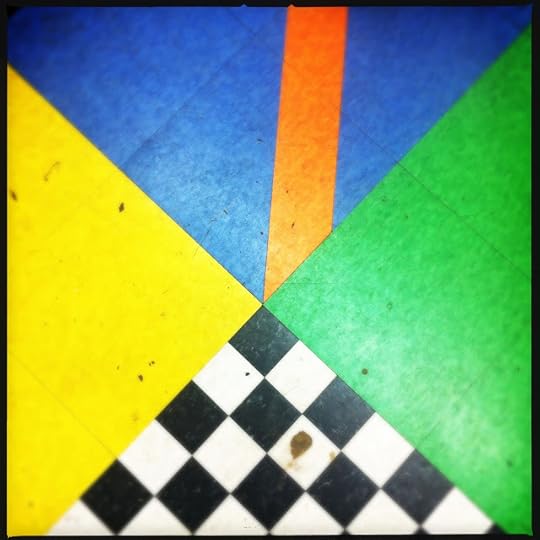 A Floor Designed and Constructed by Peter Genovese to Resemble Car Racing Caution Flags
A Floor Designed and Constructed by Peter Genovese to Resemble Car Racing Caution FlagsI did not post to this blog two nights ago, because I grew tired too early in the night. I did not post to this blog last night, because I was in West Park, New York, talking into hours of the night and early morning that even I don't usually venture into. And tonight I won't be writing a proper posting, since my busy day ended just about at 11 o'clock, leaving too little time for detail.
So here's what made my weekend a good one.
I bought some fantastic teas in Millerton, New York, and, while eating lunch at Harney & Sons, I heard the voice of the State Archivist Chris Ward (a Connecticut native) behind me, so I turned around and said, loudly across the restaurant, "Chris, this isn't quite Connecticut, but it's about as close as you can get without it being so." Then I met her 89-year-old mother celebrating her birthday (she looked great), as well as other members of the family.
I relaxed beneath life masks of women's breasts in the Flow Lounge in Kingston, New York, enjoying a beer and a shot of Tullamore Dew whiskey.
I saw an exceptional exhibition of text-based art at R&F Paints in Kingston, saw my friends Anne Gorrick and Scott Helmes (the latter, visiting from Minnesota) and enjoyed their many collaborative visual poems on exhibition.
I bought, with help from Nancy, two pieces of visual poetry by Anne and Scott, one of them consisting of four individual pieces. (I was the only person, so far as I had noticed, who had bought anything that night.) I meant to buy only one piece, but I couldn't resist the four.
I will soon be the owner of the piece used in the advertising card for this exhibition.
I inadvertently left Scott alone at R&F Paints, with no way to find us at the restaurant, and had to return to retrieve him.
I had a good dinner, with a glass of montepulciano (which is a good word to say), sharing a pizza with porcini cream sauce with Nancy.
I rode in a car with Anne back to her house, and we beat Peter, Scott and Scott's partner Kay, who had started, in a separate car, ahead of us.
I spent the night at Anne and Peter's house, along with Scott and Kay. (Nancy returned to the house, and the dogs, after dinner.)
I talked poetry and cars and all manner of other topics with these folks until a little after midnight, when Scott and Kay retired to bed, followed soon by Peter on a couch.
I drank, along with Anne, five different strange alcoholic beverages, in tiny amounts throughout the night.
I watched Peter, completely asleep, hold a tiny snifter of alcohol in his hand, without spilling it, for over an hour, and I was sure he would not spill it.
I talked to Anne on all manner of topics (but mostly _____, and _____, and especially _____) until four in the morning.
I awoke at 8:30 in the morning and wasn't the least bit tired all day.
I had a great breakfast of French toast, bacon, and one of my teas.
I toured Peter's garage and Anne's artist's studio, which are different floors of the same building.
I collected deer fur, completely separated from the body of the recently hit deer, from the front yard of Peter and Anne's house.
I rode with Scott and Kay back to my house, where we had a big lunch with Nancy and toured the Scott Helmes Museum of Art (mostly, the living room).
I said a sad goodbye to Scott and Kay.
I created an object poem out of a glass bottle, a cork, a lead band from a bottle of wine, manual typewriting and deer fur.
I prepared packages I have meant, for months to send out to friends of mine.
I ate for dinner a reprise of lunch.
I shopped for food and other provisions and unpacked everything I'd been carrying around with me this weekend.
I wrote a little, including this.
I took many many pictures of these activities.
Ron Silliman says that poetry is a social practice, that poets come together to make sense of poetry, and I did that this weekend. But I wonder if this is truly so. Right now, I am typing from the darkness, and I've been alone for hours. Poetry is a solitary practice, broken up, when poets are fortunate enough, by that smaller component that is the social practice.
As Helen said to Nancy in me in Manchester, England, one evening last year: We are not real, we are just characters in a story I am writing. We are not supposed to corporealize before her. When she returns home, we will once again become the fictional characters we are, and things will be right.
But not just yet. A little more time, please. Not yet.
ecr. l'inf.
Published on February 05, 2012 20:42
February 2, 2012
Defining Bob Grumman
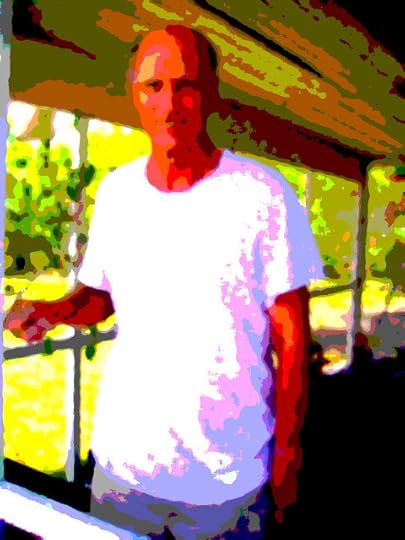 Unretouched Photo of Bob Grumman on His Lanai, Port Charlotte, Florida (14 April 2007)
Unretouched Photo of Bob Grumman on His Lanai, Port Charlotte, Florida (14 April 2007)As I like to say, Bob Grumman (who turned 71 today) is my oldest friend, because there's no way I have any friends older than he is. But, honestly, it's because we've known each other (if mostly through the mails and virtually) since 1987, when I was as old as my daughter is now. Since it is Bob's birthday today, I celebrate as I always do, with a posting dedicated to him. This one, as most of them, is a roast.
I began the tradition of roasting Bob because he loves argument, and this year I provide this roast in the form of a series of definitions for words important to Bob's life. Since I don't put aside a blog posting for just anyone every year, Bob should be honored, which indeed he is. So the following are arguments with him, gentle disagreements, mild teasing, and random musings, all mixed together to cause him confusion.
In case you wonder why Bob puts up with me, it is because I'm his literary executor. In the unlikely case he ever dies, I am clearly the person charged with finding a proper home for his personal papers, which charge is clearly demonstrated by sticky notes stuck all over his filing cabinets at his home. That is, honestly, what he told me, but I'm worried that cats have knocked them off the cabinets and that Bob's family will say to me, upon my arrival, "Bob was literary? Who are you?"
Luckily for me, I'm likely to expire before the immortal Bob Grumman.
(And I mean, really lucky!)
bob, n. 1. a breast 2. an amorphous mass, especially if it appears to be corpulent 3. the rounded handle of a think 4. an entity part-animal and part-machine 5. the definition of a definer of refined madness 6. a bobbin
bob, v. 1. to move up and down with the motion of waves in the water 2. to dunk a head into a barrel of water to remove an apple by capturing it with your teeth 3. to move one's body from side to side, especially to avoid capture 4. to prostrate oneself at the altar of one's beliefs 5. to bedevil, devein, or rebob 6. to bobbit
connecticut, n. 1. a cut and connected continuity 2. a state of disorder 3. a place that holds nutmeg 4. a state in a new England in a north America and beside and atlantic ocean 5. the birthplace of Bob Grumman 6. where the rich protect themselves from reality
definition, n. 1. the particular angularity (say, of a face) that provides a clear idea of the shape that holds (say, that face) together as a unified and attractive whole 2. the written or explained meaning of a word 3. the explanation of what a thing, event, or person means 4. the source of all argument 5. why a slip of her entered his consciousness and he imagined her glance as the smallest exhalation of breath that he could breathe into his body so that he imagined he was filled with her presence and could never lose it because it had become a part of his ever circulating blood 6. whatever Bob says something means
florida, adj. 1. red in the face 2. filled with flowers 3. felled by followers 4. retired into by Bob Grumman 5. hurricaneswept 6. flat
groundhog day, n. 1. the second day of February 2. the day in which the remaining length of winter is determined by whether or not a groundhog (usually one in Punxatawney, Pennsylvania) sees its own shadow 3. a day that continues to repeat itself 4. a day that continues to repeat itself, but with modifications 5. the birthday of Bob Grumman, James Joyce, and Ayn Rand 6. a reason for leaving
grumman, n. 1. a bum covered with crumbs 2. a bottom covered with crumbs 3. a crumb-catcher 4. a rubberband 5. a ruptured rump 6. a grumptious mump
infraverbal, adj. 1. alphaconceptual 2. intrapuntal 3. capricious 4. caperlicious 5. deciduous 6. dord
mathemaku, n. 1. Japanese mathematics 2. angular poetry 3. verdant desert 4. intricate denominations 5. a form of poetry practiced by Bob Grumman that carries out mathematical operations (frequently, long division) on words and images 6. visuamathepoetry
poeticks, n. sing. 1. the ticking of a clock in a story by Edgar Allan Poe 2. a theory of poetry, particularly a personal one defined by a specific poet (not "person") 3. any poetry focused on the arachnid tick 4. a sense of out-of-itness 5. the small unintentional facial spasms of the moronic class (as opposed to the intelligentsia) 6. Bob Grumman's weblog
spring, v. 1. to season 2. to jump up or forward 3. to run out of the ground with water 4. to rain into 5. to grow forth from 6. to recall one's childhood experiences of
taxonomy, n. 1. a systematic description of a branch of knowledge 2. a systematic classification of a branch of knowledge 3. the systematic classification of all plant and animal life 4. a series of distinctions made against a body of overlapping similarities and dissimilarities 5. whatever Bob says it is 6. a tax on you
visimagist, n. 1. a visual artist 2. a visual artist 3. a visual artist 4. a visual artist 5. a visual artist 6. an artist
visual poetry, n. 1. a form of poetry that combines words and images or plays heavily and semiotically upon the visual presentation of words 2. a form of poetry that combines text and images or plays heavily and semiotically upon the visual presentation of text 3. a form of art that consists of any visually focused examinations of the possible means by which text can fabricate and represent meaning 4. a form of visual art that focuses on the text within it even if the text does not predominate 5. vizMcPoetry 6. whatever Bob says it is
ecr. l'inf.
Published on February 02, 2012 18:51
February 1, 2012
Films Watched: January 2012
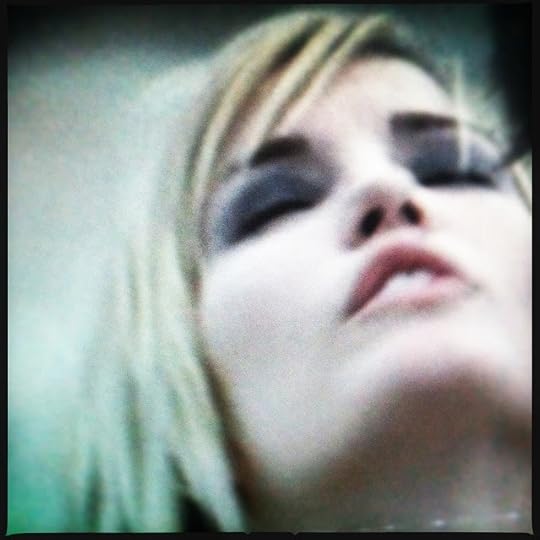 Captured Still from Wristcutters: A Love Story (2006)
Captured Still from Wristcutters: A Love Story (2006)Over the course of last month, the first of this newyear without a real winter, I watched twenty-four films, fewer than I thought Ihad. But I didn't count having watched every episode of Downtown Abbey (even the entirety of the season playing only now inthe United States) in the course of five days. Film is film; TV is TV.
Film is escape in some way for me, but it is also adesperate search for all kinds of beauty, an attempt to find a means ofthinking about life, an indulgence in the expression of what is human, evenwhen dirty, heartless, cruel. A number of these films affected me in one way oranother that they wormed their way into writing I did over the month. A few ofthem took me over for a day that I ended with a 5000-word essay.
As I look over this list, I see that I liked many ofthese films, at least to some degree, but which one did I love? Only the mostEuropean of them: Certified Copy, a film that doesn't resolve itself, thatdoesn't allow you to understand it, that switches between three languages(English, French, and Italian) incessantly, that seems about hope and desire,despair and disregard, that is about art but also about the human, thatquestions what it shows us, that causes us to question what we see, that starsa well known French movie actress and a British opera singer, that is asurprise, and a delicate antipasto eaten in anticipation of a delicious mealthat we know will be just a bit too filling.
Only art. Only art. Only art.
January1, 2012
1. ThePassenger (126 min, Michelangelo Antonioni, 1975)
January6, 2012
2. HappyAccidents (110, Brad Anderson, 2000)
3. ToyStory 3 (103 min, Lee Unkrich, 2010)
January7, 2012
4. TheGirl with the Dragon Tattoo (152 min, Niels Arden Oplev, 2009)
January8, 2012
5. TheGirl Who Played with Fire (129 min, Daniel Alfredson, 2009)
January10, 2012
6. TheGirl Who Kicked the Hornet's Nest (147 min, DanielAlfredson, 2009)
January11, 2012
7. MyArchitect: A Son's Journey (116 min, Nathaniel Kahn, 2003)
January14, 2012
8. SolitaryMan (99 min, Brian Koppelman and David Levien, 2009)
January15, 2012
9. Cashback (102min, Sean Ellis, 2006)
10. TheNext Three Days (113 min, Paul Haggis, 2010)
January16, 2012
11. Phoebein Wonderland (106 min, Daniel Barnz, 2008)
January19, 2012
12. TimeIndefinite (114min, Ross McElwee, 1993)
January19, 2012
13. Lifein a Day (95 min, Kevin Macdonald and Natalia Andreadis,2011)
January21, 2012
14. TheGirl with the Dragon Tattoo (158 min, David Fincher, 2011)
January23, 2012
15. Alfie (103min, Charles Shyer, 2004)
January25, 2012
16. TiMER(99 min, Jac Schaeffer, 2009)
January27, 2012
17. CertifiedCopy (106 min, Abbas Kiarostami, 2010)
18. Wristcutters:A Love Story (8 min, Goran Gukic, 2006)
19. Trust (106 min, David Schwimmer, 2010)
January28, 2012
20. BrightStar (2009, Jane Campion, 2009)
21. TheArtist (100 min, Michel Hazanavicius, 2011)
22. Shame (101min, Steve McQueen, 2011)
January30, 2012
23. AllGood Things (111 min)
January31, 2012
24. PanicRoom (114 min, David Fincher, 2002)
ecr.l'inf.
Published on February 01, 2012 19:57
January 31, 2012
In the Field, I am the Absence of Field
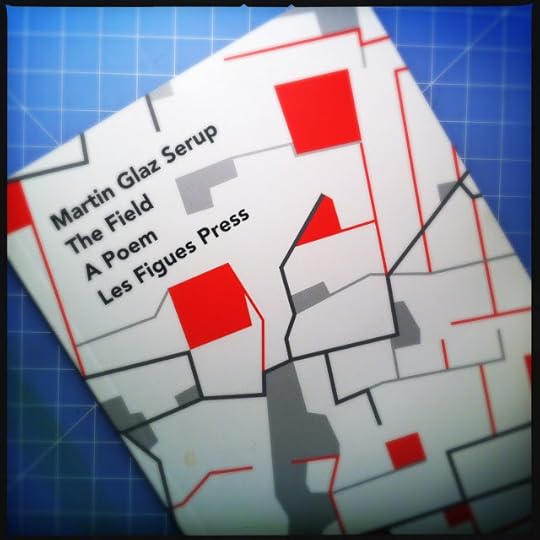
I read Martin Glaz Serup's book The Field on a plane right from New York City to Portland, Oregon. I was flying across the continent for the weekend and brought this along as my reading matter for the trip west. Still, almost three months later, the book stays with me. It's not merely that I remember it; it is that is sometimes appears in my life. It is manifested before me. Probably because it actually reminds me of my life. (NB: This is a book where the protagonist is a field.) It is manifested within me.
This is a book where the protagonist is a field. But not a usual field. As becomes clear from this sentence:
The field in sun, the field in snow, the field alone and with others, the field in the field with the Boy Scouts by a bonfire.
Particularly: "the field in the field."
This booklength prose poem told in episodes is defined by two features. The first is that the main character is said to be a field but acts as if he, for it is a he, is a middle aged man beset by ennui and general disaffectedness. He is an anonymous man in an anonymous post-industrial and probably suburban landscape that has no principal attractions. The second defining feature of the book is that it is told in an affectless, totally unemotional manner that befits this character.
The best experience of nature the field has had was at the fair ground in Roskilde; it went up in a little aeroplane, there were four people in the plane, it was very intimate, nature is beautiful seen from above, the plane was red.
So how effective is a book of about a boring run-of-the-mill suburbanite told with language as flat as possible?
Very. And the reason is because the book is filled with everything (wondering, humor, despair, revulsion), yet all of these pieces come into play in an unadorned way. Emotion is not adorned by emotionality. Sex is not discussed erotically. Everything is told as if it is everything else. The world is white and vanilla, because the field is white and vanilla.
The field is a lot.
The story of an extraordinarily ordinary man, one with many thoughts, but one whose thoughts are subdued, held in placed, tied tightly to their moorings, and unable to escape. Stories are told, but they do not connect (except via style and character). They do not tell a story. There is no story arc. Just a flat line, indistinguishable from death.
The book is held in place by its ordinariness, but it vibrates. It is a book spinning in place between two opposing forces. On the face of it, it is a story of nothing, of nothing much, of a nobody, and there is nothing to say about it, and the book says it all. But, on the other hand, the book is a satire against meaningless life, the pursuit of empty happinesses, the life lived without thought and serious intent.
The interviewer doesn't understand either, what do you mean, he asks the musician, the musician answers: no fear, no envy, not evil. This reassures the field somewhat, it sounds like an artist's slogan, so the musician is a typical artist: no doubt good at his thing, but detached from reality and non-committal.
If I collect everything together I know about this book, I am left with only one thing, the only thing the book is made out of: words. And the words work. When I think of this book, I am reminded most forcefully of William Faulkner's As I Lay Dying, which was presented to us as a novel, but maybe it too was a poem. The "chapters" of The Field vary in length as in Faulkner's book. The various narrators in Faulkner often speak in a flat affectless way. And yet we are pulled in. The plan was red; my mother is a fish.
There is no story here, just vignettes of a life. Sometimes just a line: "The field feels ashamed of taking pictures." Sometimes two. Sometimes a paragraph taking up a third of the page. Sometimes a paragraph taking up most of a page. And, once or twice, the story grows out of control and onto a little bit of a second page.
The field sometimes thinks it's unhappy in a mild and ordinary way that makes it happy because it thinks that it's probably perfectly normal, and that makes it happy because it thinks things could be much worse, which makes it afraid because it thinks things could still get much worse, so it tries to think of something else.
The book presents the movement of thinking, a way of thinking through a life, or living through a thought. Even when the thoughts are small. Some of the thoughts are painful, or should be, but they are presented to us as if shrouded in rolls of cotton batting. We can't feel pain because of the protective padding of the words.
The field cannot feel the pain either. Because he has made himself so. Because he is an enterprise of human activity rather than a human being. Because he has given up his humanity. Because he sits, still but thinking, as a representation of what we shouldn't be. And it is too late for crying.
So he breathes and he goes on. He is a field. He is a screen. He is white enough that we can project ourselves onto him and view ourselves as if looking into a mirror.
When the field puts its ear to the ground it can hear a faint humming.
Dipping back into this book tonight, the whole thing comes back to me, and I am humming with its words, with the suppurating yet beautiful humanity of its blank and banal destitution, with the idea that this writing is inspiring in its ability to present the uninspiring in a moving and intellectual way, in a manner that shows us that we are human intellect and bodies of beating hearts. And need to remember that. And need to honor both those halves of our Manichaean wholes.
_____
Serup, Martin Glaz. The Field. Translated by Christopher Sand-Iversen. Les Figues Press: Los Angelese, Calif., 2011. US$15.
ecr. l'inf.
Published on January 31, 2012 20:35



